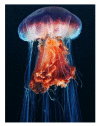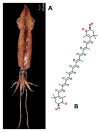Collective Locomotion of Human Cells, Wound Healing and Their Control by Extracts and Isolated Compounds from Marine Invertebrates
- PMID: 32466475
- PMCID: PMC7321354
- DOI: 10.3390/molecules25112471
Collective Locomotion of Human Cells, Wound Healing and Their Control by Extracts and Isolated Compounds from Marine Invertebrates
Abstract
The collective migration of cells is a complex integrated process that represents a common theme joining morphogenesis, tissue regeneration, and tumor biology. It is known that a remarkable amount of secondary metabolites produced by aquatic invertebrates displays active pharmacological properties against a variety of diseases. The aim of this review is to pick up selected studies that report the extraction and identification of crude extracts or isolated compounds that exert a modulatory effect on collective cell locomotion and/or skin tissue reconstitution and recapitulate the molecular, biochemical, and/or physiological aspects, where available, which are associated to the substances under examination, grouping the producing species according to their taxonomic hierarchy. Taken all of the collected data into account, marine invertebrates emerge as a still poorly-exploited valuable resource of natural products that may significantly improve the process of skin regeneration and restrain tumor cell migration, as documented by in vitro and in vivo studies. Therefore, the identification of the most promising invertebrate-derived extracts/molecules for the utilization as new targets for biomedical translation merits further and more detailed investigations.
Keywords: cell migration; marine invertebrates; wound healing.
Conflict of interest statement
The authors declare no conflict of interest.
Figures































Similar articles
-
Histone Deacetylase Inhibitors from Marine Invertebrates.Biology (Basel). 2020 Nov 28;9(12):429. doi: 10.3390/biology9120429. Biology (Basel). 2020. PMID: 33260710 Free PMC article. Review.
-
Medicinal benefits of marine invertebrates: sources for discovering natural drug candidates.Adv Food Nutr Res. 2012;65:153-69. doi: 10.1016/B978-0-12-416003-3.00009-3. Adv Food Nutr Res. 2012. PMID: 22361185 Review.
-
In vitro studies to evaluate the wound healing properties of Calendula officinalis extracts.J Ethnopharmacol. 2017 Jan 20;196:94-103. doi: 10.1016/j.jep.2016.12.006. Epub 2016 Dec 10. J Ethnopharmacol. 2017. PMID: 27956358
-
Tissue Extract from Brittle Star Undergoing Arm Regeneration Promotes Wound Healing in Rat.Mar Drugs. 2023 Jun 28;21(7):381. doi: 10.3390/md21070381. Mar Drugs. 2023. PMID: 37504912 Free PMC article.
-
Modeling keratinocyte wound healing dynamics: Cell-cell adhesion promotes sustained collective migration.J Theor Biol. 2016 Jul 7;400:103-17. doi: 10.1016/j.jtbi.2016.04.015. Epub 2016 Apr 19. J Theor Biol. 2016. PMID: 27105673 Free PMC article.
Cited by
-
Haemolymphatic Parameters in Two Aquaculture Crustacean Species Cherax destructor (Clark, 1836) and Cherax quadricarinatus (Von Martens, 1868).Animals (Basel). 2022 Feb 22;12(5):543. doi: 10.3390/ani12050543. Animals (Basel). 2022. PMID: 35268111 Free PMC article.
-
Exploring the Biotechnological Value of Marine Invertebrates: A Closer Look at the Biochemical and Antioxidant Properties of Sabella spallanzanii and Microcosmus squamiger.Animals (Basel). 2021 Dec 14;11(12):3557. doi: 10.3390/ani11123557. Animals (Basel). 2021. PMID: 34944333 Free PMC article.
-
Autologous tenon capsule packing to treat posterior exit wound of penetrating injury: A case report.World J Clin Cases. 2021 Jul 6;9(19):5211-5216. doi: 10.12998/wjcc.v9.i19.5211. World J Clin Cases. 2021. PMID: 34307569 Free PMC article.
-
Histone Deacetylase Inhibitors from Marine Invertebrates.Biology (Basel). 2020 Nov 28;9(12):429. doi: 10.3390/biology9120429. Biology (Basel). 2020. PMID: 33260710 Free PMC article. Review.
-
A Promotion Role of MIR31 in the Process of Vocal Fold Wound Healing.PPAR Res. 2023 Aug 8;2023:4672827. doi: 10.1155/2023/4672827. eCollection 2023. PPAR Res. 2023. PMID: 37588448 Free PMC article.
References
Publication types
MeSH terms
Substances
Grants and funding
LinkOut - more resources
Full Text Sources

